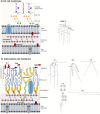Various Facets of Pathogenic Lipids in Infectious Diseases: Exploring Virulent Lipid-Host Interactome and Their Druggability
- PMID: 32833058
- PMCID: PMC7443855
- DOI: 10.1007/s00232-020-00135-0
Various Facets of Pathogenic Lipids in Infectious Diseases: Exploring Virulent Lipid-Host Interactome and Their Druggability
Abstract
Lipids form an integral, structural, and functional part of all life forms. They play a significant role in various cellular processes such as membrane fusion, fission, endocytosis, protein trafficking, and protein functions. Interestingly, recent studies have revealed their more impactful and critical involvement in infectious diseases, starting with the manipulation of the host membrane to facilitate pathogenic entry. Thereafter, pathogens recruit specific host lipids for the maintenance of favorable intracellular niche to augment their survival and proliferation. In this review, we showcase the lipid-mediated host pathogen interplay in context of life-threatening viral and bacterial diseases including the recent SARS-CoV-2 infection. We evaluate the emergent lipid-centric approaches adopted by these pathogens, while delineating the alterations in the composition and organization of the cell membrane within the host, as well as the pathogen. Lastly, crucial nexus points in their interaction landscape for therapeutic interventions are identified. Lipids act as critical determinants of bacterial and viral pathogenesis by altering the host cell membrane structure and functions.
Keywords: Drug development; Host–pathogen interactions; Lipid biosynthesis; Lipid rafts; Membrane organization; Virulence-associated lipids.
Conflict of interest statement
The authors declare that they have no conflict of interests.
Figures




Similar articles
-
LY6E Restricts Entry of Human Coronaviruses, Including Currently Pandemic SARS-CoV-2.J Virol. 2020 Aug 31;94(18):e00562-20. doi: 10.1128/JVI.00562-20. Print 2020 Aug 31. J Virol. 2020. PMID: 32641482 Free PMC article.
-
The Role of Lipid Metabolism in COVID-19 Virus Infection and as a Drug Target.Int J Mol Sci. 2020 May 17;21(10):3544. doi: 10.3390/ijms21103544. Int J Mol Sci. 2020. PMID: 32429572 Free PMC article. Review.
-
COVID-19: viral-host interactome analyzed by network based-approach model to study pathogenesis of SARS-CoV-2 infection.J Transl Med. 2020 Jun 10;18(1):233. doi: 10.1186/s12967-020-02405-w. J Transl Med. 2020. PMID: 32522207 Free PMC article.
-
COVID-19 challenging cell biology.Protoplasma. 2020 May;257(3):619-620. doi: 10.1007/s00709-020-01506-z. Epub 2020 Apr 24. Protoplasma. 2020. PMID: 32333127 Free PMC article. No abstract available.
-
Entry Inhibitors: Efficient Means to Block Viral Infection.J Membr Biol. 2020 Oct;253(5):425-444. doi: 10.1007/s00232-020-00136-z. Epub 2020 Aug 30. J Membr Biol. 2020. PMID: 32862236 Free PMC article. Review.
Cited by
-
Adjustment in the Composition and Organization of Proteus mirabilis Lipids during the Swarming Process.Int J Mol Sci. 2023 Nov 17;24(22):16461. doi: 10.3390/ijms242216461. Int J Mol Sci. 2023. PMID: 38003652 Free PMC article.
-
Liposomes: from August Wassermann to vaccines against COVID-19.ADMET DMPK. 2023 Jun 30;11(4):487-497. doi: 10.5599/admet.1926. eCollection 2023. ADMET DMPK. 2023. PMID: 37937239 Free PMC article. Review.
-
Distinct lipid metabolic dysregulation in asymptomatic COVID-19.iScience. 2021 Sep 24;24(9):102974. doi: 10.1016/j.isci.2021.102974. Epub 2021 Aug 11. iScience. 2021. PMID: 34396083 Free PMC article.
-
Lipid-A-dependent and cholesterol-dependent dynamics properties of liposomes from gram-negative bacteria in ESKAPE.Sci Rep. 2022 Nov 14;12(1):19474. doi: 10.1038/s41598-022-22886-7. Sci Rep. 2022. PMID: 36376343 Free PMC article.
-
dRNASb: a systems biology approach to decipher dynamics of host-pathogen interactions using temporal dual RNA-seq data.Microb Genom. 2022 Sep;8(9):mgen000862. doi: 10.1099/mgen.0.000862. Microb Genom. 2022. PMID: 36136078 Free PMC article.
References
-
- Albulescu L, Bigay J, Biswas B, Weber-Boyvat M, Dorobantu CM, Delang L, van der Schaar HM, Jung YS, Neyts J, Olkkonen VM, van Kuppeveld FJM, Strating JRPM. Uncovering oxysterol-binding protein (OSBP) as a target of the anti-enteroviral compound TTP-8307. Antivir Res. 2017;140:37–44. doi: 10.1016/j.antiviral.2017.01.008. - DOI - PubMed
Publication types
MeSH terms
Substances
Grants and funding
- EMR/2016/005414/Science and Engineering Research Board/International
- WOS-A/CS-16/2018/Science and Engineering Research Board/International
- 201805BRE01RP04922/Board of Research in Nuclear Sciences/International
- INSPIRE/Department of Science and Technology, Ministry of Science and Technology/International
- Ramalingaswami Fellowship/Department of Biotechnology , Ministry of Science and Technology/International
LinkOut - more resources
Full Text Sources
Miscellaneous

